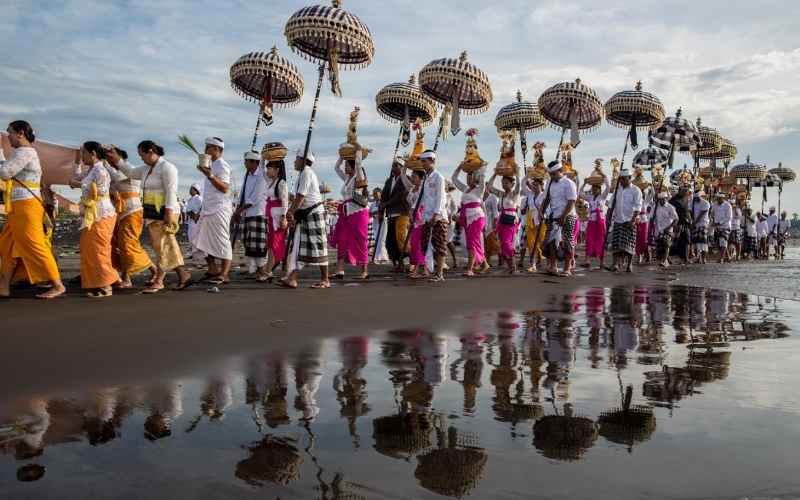Before the nyepi holy day (silent day), a purification ceremony and ritual, precursor to the Nyepi holy day is carried out. Melasti is a Hindu Balinese purification ceremony and ritual, which according to the Balinese calendar, is held several days prior to the Nyepi holy day. The purification ceremony was meant as the ritual to cleanse the world from all the filth of sin and bad karma, through the symbolic act of acquiring the Tirta Amerta, which is the “water of life” according to Balinese Hindu belifes. Held once year, this ceremony welcomes the pupose is to to purify both Bhuana Alit (the soul) and Bhuana Agung (the universe). Furthermore, the ceremony brings four values to the Balinese Hindu society , to remind people of their devotion to God, to build awareness for the alleviation of suffering in living together as a society, to strengthen the soul with spritual self-cleansing, and to preserve nature.
During Melasti, village communities (or banjar) travel together to their closest source of holy water (lake or beach). It’s hard to miss this ceremony, as lines of ladies carrying offerings on theur heads (a procession called Mapeed), men carrying the pratima shrines on their shoulders and other holding up Balinese umberellas take to the streets and walk from temple or village to teh coast. In any situation, the Balinese gamelan orchestra are always nearby to add the atmosphere. Performed with a parade procession by throusands of Hindu people as participants, the ritual begins with the preparation of a walking crowd with the pratima placed in a jempana, a carriage for the Pratima, and paraded toward the nearest water source that is located not far from the temple in a nearby village. People walk together and help each other to bring the Pratima to the water source with a percussion accompaniment called a Belleganjur.
At the edge of the water source, the procession takes the holy water for a cleaning ritual dedicated to all participants and the Pratima to follow as the next step. this spiritual concept od a cleansing procession is meant to eliminate the suffering of the people from the attachment of the material world. At the beach, the pratima shrines and icons in which ancestral sprits reside (Rangda or Barong puppets) are laid down. the blessed items themsleves are symbols of the cosmos, the universe, Bhuana Agung (larger world), whilst humans are considered in Bhuana Alit (littel world). But a relationship exists within one-another. Here, the priest will pray and chant is mantras, flicking holy water, his flower and ringing his prayer bell. Around the pratima, worshippers join in prayer too among other rites of worship from dance, to the ngeruk knife ritual, many fall into a trance (surupan) during such a holy time, as they are induced into a state that brings them closer to the deities. After the cleansing prcession, the shrine and incons are carried back to the temple and keep it sacred. Every group that has done encircling the beach continued their cavalcade toward their own temple put their pratima back. As like as their arrival so does their homing, they went back to their temple by feet.
The meaning of Melasti ceremony is a self-cleaning process of human as well as the entire universe with the sacred Hindu rituals. The purpose is to purify Bhuana Alit aswell as Bhuana Agung (small world and teh upper world) from bad influences, bad deeds and bad thoughts. Bhuana Alit means the heart or soul of each individual who is living in this world. Meanwhile, the Bhuana Agung means the wide world or this universe. The ceremony is a very important value to remind how important this life as well as we need a day to purify oureselves and the universe. In addition, all the components that is living in this world has a clean soul, therefore, the world can survive from the threat of bad things.
It is a spiritual journey, it is magical. The hundred miles long march is only taken by a journey within only half day on the streets, walking and sometimes running across the busy traffic of Bali;s streets. With all the purpose and in the name of tradition, not only the Balinese society should support this unique ritual, but also other communities that live side by side and the higher power of the society, the government itself, to guide all the people while doing this sacred ritual.

